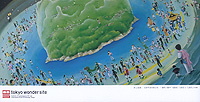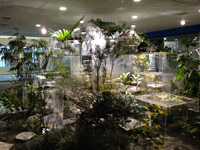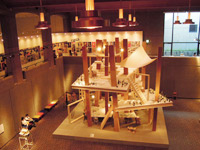 |
Picks is a monthly sampling of Japan's art scene, offering commentary by a variety of reviewers about exhibitions at museums and galleries in recent weeks, with an emphasis on contemporary art by young artists. |
 |
 |
|
|
 |
 |
|
| Hisashi Matsumoto: Beast Attacks!! 2 -- over drive |
| 10 July - 31 August 2012 |
BAMI gallery
(Kyoto) |
 |
| Matsumoto's sinister images of youths gnawing like beasts at chunks of meat, or young punks sneering at the viewer, all hint at violence and evil deeds; all, the artist says, are self-portraits. The faces are dense with inarticulable emotions and spiritual impoverishment, and the visitor is drawn willy-nilly into the depths of their disillusion. |
|
|
 |
 |
 |
|
| Kanae Murakami: Between the Sea and the Mountain |
| 4 - 26 August 2012 |
Tokyo Wonder Site Hongo
(Tokyo) |
 |
| Think of a series of paintings that are a cross between Bosch's Garden of Earthly Delights and Japanese Yamato-e of the classical "pastimes and pleasures" genre. In terms of technique these are Western-style works, but they evince a pronounced East Asian worldview, represented by such elements as swathes of mist and lion-dance lions poking their heads out of the canvas. Murakami's compositions are full of human figures, but as if that weren't enough, she has playfully painted more figures -- who appear to be pilgrims making the rounds of holy places -- directly onto the walls between the pictures. |
|
|
|
|

|
 |
 |
 |
 |
| Sendai Collection Vol. 16 |
| 7 - 12 August 2012 |
Sendai Artist-Run Place (SARP)
(Miyagi) |
 |
| This is the 16th in the "Sendai Collection" series of photo exhibitions since the project, which aims to collect 10,000 images of the northeastern city, was launched in 2001. The organizer, Sendai-based photographer Toru Ito, is joined by seven colleagues: Shiro Ouchi, Wataru Matsutani, Makoto Kotaki, Kotobuki Saito, Hidekazu Katakura, Reiko Anbai, and Ryuji Sasaki. Their objective -- to preserve a visual record of buildings, bridges, streets and other "nameless scenes that will vanish with the passage of time" -- resonates even more poignantly in the aftermath of the March 2011 earthquake and tsunami that devastated much of the city. |
|
|
 |
 |
 |
| Midori Ikeda: I Love You, I Hate You |
|
|
NADiff a/p/a/r/t
(Tokyo)
|
 |
| Midori Ikeda is the name of an art unit consisting of Midori Mitamura and Masanori Ikeda. Their new work, I Love You, I Hate You, is staged in a half-century-old precision sheet metal plant in the industrial neighborhood of Itabashi, Tokyo. In this space, which resembles a movie set yet reeks of deja vu, the two artists act out "the ups and downs of life for a man and a woman together." This is neither a play nor a film, however; the artists tell their story through a series of still photographs, a choice of medium that is a significant factor in the work's impact. |
|
|
|
|
|
|
|

|
 |
 |
 |
 |
| Okamura Design Space R: Flow_er |
| 24 July - 10 August 2012 |
Okamura Garden Court Showroom
(Tokyo) |
 |
| Located in the Hotel New Otani, the Okamura Corporation's Design Space R recently featured a collaborative installation by architect Akihisa Hirata and garden planner Yuichi Tsukada. Clear acrylic panels divided the space in a series of folds that dissolved the distinction between interior and exterior. Scattered throughout Hirata's geometric world were dozens of plants, while water dripped from above, branching and flowing across the space. Definitely a new kind of garden. |
|
|
 |
 |
| Makoto Morimura: Daily Hope |
| 13 July - 12 August 2012 |
Gallery Out of Place
(Nara) |
 |
| For this solo show, Morimura covered the walls of the gallery with English-language newspapers on which he had applied whiteout fluid to obliterate every bit of text except the letters H, O, P, and E. One immediately wonders if this "Daily Hope" concept was inspired by the March 2011 disaster, but the artist avers he began the project several months before then. One of its underlying themes is surely the difficulty of achieving true communication with mere words. |
|

|
 |
 |
 |
 |
|
| Contemporary Art Biennale of Fukushima 2012 |
| 11 August - 23 September 2012 |
Fukushima Airport
(Fukushima) |
 |
| The fifth such event held at Fukushima Airport, this year's Biennale was the first since the nuclear disaster that befell the prefecture, and it attracted some notable artists, among them Yoko Ono, Kenji Yanobe, and Tatsuo Kawaguchi. A project initiated by students at Fukushima University under the leadership of professor Keiichi Watanabe, the show occupied various spaces in the airport, including the terminal lobby, the front garden, and the international cargo facility. Yanobe's monumental Sun Child sculpture in a hazmat suit dominated the entrance, while Ono's Sky Piece dovetailed with this year's "sky" theme. |
|
|
 |
 |
 |
| Arts & Life: Houses for Living |
| 15 July - 30 September 2012 |
Tokyo Metropolitan Art Museum
(Tokyo) |
 |
| Winners in a competition of designs for "houses of the future," the models in this exhibition tended to imitate the styles of today's young architectural lions, thus providing an inadvertent overview of popular trends in contemporary Japanese architecture. The standout in more ways than one was the life-size model by the first-prize winner, Suzuko Yamada. A dominating presence, her open design, consisting of slabs and pillars at perilous angles and devoid of walls or roof, was nicely suited to its location in a sunken space in the middle of the hall.
|
|
|
|
|
|
|
 |
 |
| Yumiko Utsu: Rose Window |
| 18 August - 30 September 2012 |
G/P Gallery
(Tokyo) |
 |
| Photo-artist Utsu is known for her colorful, sometimes cute, but just as often grotesque or erotic collages featuring bizarre juxtapositions of her favorite motif, food. In her new series Rose Window she fully indulges her monomaniacal tendencies, arranging a variety of objects -- vegetables, fruit, fish -- into concentric compositions overlaid with a web of circular paper cutouts. Truly a panoply of "food on parade." |
|
 |
 |
 |
| Story of the Tokyo Metropolitan Art Museum |
| 15 July - 30 September 2012 |
Tokyo Metropolitan Museum
(Tokyo) |
 |
| Celebrating the Met's reopening this spring after a long period of renovation, this retrospective used drawings and models to look back on its 86-year history and the people who figured largest in it. They range from Kyushu entrepreneur Keitaro Sato, who donated the museum's construction costs (1 million yen, equivalent to 3.2 billion yen today) to the Tokyo government back in the Taisho era, to Tokyo School of Fine Arts president Naohiko Masakai, who guided the museum in its infancy, to the architects who designed its old and new buildings, Shinichiro Okada and Kunio Maekawa. |
|
|
|
|
 |
|